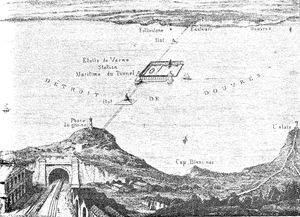History of Channel Tunnel - Facts and Design
Channel Tunnel (in French “Le tunnel sous la Manche” or “Chunnel”) is a rail tunnel below the English Channel. Its length is 50.5 km and it connects Folkestone, Kent, in the United Kingdom, with Coquelles, Pas-de-Calais, near Calais in northern France. It was finished in 1994. Tunnel is used for traffic of high-speed passenger trains, trains that carry automobiles and other vehicles and cargo trains.
Idea for a tunnel under the English Channel existed as early as 19th century. Albert Mathieu, a French mining engineer, was the first to propose the tunnel in 1802. His plan was for traffic to be done by horse-drawn coaches, illumination would be done with oil lamps and the tunnel would exit the surface in the middle of the Channel where an artificial island would be and where coaches could change horses. The first geological and hydrographical surveys for this tunnel were performed in 1830s by Aimé Thomé de Gamond. He finished in 1856 and presented his results to Napoleon III. Thomé de Gamond then proposed his version of a mined railway tunnel from Cap Gris-Nez to Eastwater Point with an airshaft on the Varne sandbank. On the other side of the Channel and in 1865 George Ward Hunt, politician and statesman, also proposed an idea for a tunnel below the Channel. Idea was repeated by William Low and Sir John Hawkshaw in 1866 but, agan, nothing was done except preliminary geological studies. The first agreement on building the tunnel was signed by France and England in 1876. In 1881, the first digging started. On the English side Sir Edward Watkin, British railway entrepreneur, dug a pilot tunnel of 1,893 m in length. On the French side, Alexandre Lavalley, a Suez Canal contractor, dug up a tunnel of 1,669 m. A year later works stopped, because British politicians and press thought that, with a tunnel under a Channel, British defense would be weaker.

After the First World War, in 1919, he British prime minister David Lloyd George tried to restart the idea and again suggested it to The France during the Paris Peace Conference but, again, nothing became of that. Fear, nationalism and paranoia (as well as Second World War) didn't allow for any beginning of the works on the tunnel until 1955 when air power of both countries became so strong that tunnel would not be used in any kind of attack so defense arguments became irrelevant. British and French governments agreed to perform technical and geological surveys which were carried out in 1964 and 1965. Construction began in 1974 but in 1975 the British government canceled the project. All that continued (ideas, oppositions and problems) until, in 1987, the Treaty of Canterbury was signed by British Prime Minister Margaret Thatcher and French President François Mitterrand which allowed the project to proceed. France started drilling in June 1988 while the UK began in December of the same year. But it wasn't all smooth – 10 people died in the first months of the drilling. Eleven tunnel boring machines drilled in total and they made two rail tunnels plus a service tunnel. In late 1990, tunnels from both sides (French and British) touched. Queen Elizabeth II and the French president, François Mitterrand opened the bridge in a ceremony that was held on May 6, 1994. 13,000 workers engineers, and technicians worked on this tunnel. Length of a tunnel is 50.5 km and it is located at depth of 40m bellow the sea bed (on average). Since it was opened, Channel Tunnel has carried more than 57 million passengers. To travel across the tunnel you would need 35 minutes.

